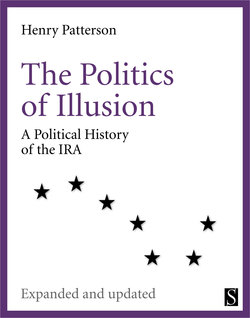Читать книгу The Politics of Illusion - Henry Patterson - Страница 3
На сайте Литреса книга снята с продажи.
Introduction
ОглавлениеSince the original version of this book was published in 1989, the collapse of the Soviet Union has radically transformed the international context in which Irish republicanism exists. Although the 1916 Rising predated the Bolshevik Revolution, it occurred in a period of rising working-class militancy in Ireland and Britain, and for most of its history the republican movement that developed out of the Rising had a complex and fraught relationship with working-class organisations and struggles. What distinguished The Politics of Illusion from histories of republicanism existing at the time was its focus on this relationship as key to understanding the movement’s ability periodically to resuscitate itself from the dead-end of a sterile, elitist militarism.
Until the Treaty split and Civil War, the revolutionary nationalist movement of Sinn Féin and the IRA, which had emerged in the aftermath of the Easter Rising of 1916, had strongly insisted on the trans-class and generally ‘non-sectional’ nature of its project. In the wake of defeat, however, the opponents of the new order were forced to look to a range of hitherto neglected issues as a means of maintaining and expanding their support. The conditions of small farmers and landless labourers; low wages, unemployment and bad housing in Dublin and the larger towns; the fears and resentments of the Catholic minority in the newly established Unionist regime in Northern Ireland: all would represent opportunities for republicans. Yet they would be severely inhibited by the ideological legacy of nationalist purism and by the organisational weight of a secretive militarism which maintained a deep distrust of ‘politics’. In the inter-war period and again in the 1960s and 70s, in reaction to the defeats of what came to be seen as an apolitical and purely militarist republicanism, there emerged what this book will call ‘social republicanism’: an effort to rally the masses to the ‘anti-imperialist struggle’ by taking up economic and social issues. This book is a study of social republicanism and its role in a number of crucial periods in modern Irish history. It will demonstrate the extreme difficulty that republicanism has experienced in managing the tensions that involvement in economic and social issues creates. These derive in part from the secretive nature of the tradition but also from the real danger that when such issues are taken seriously the central objective of republican struggle is put in question. From Peadar O’Donnell in the 1930s to Gerry Adams in the 1980s, the attractions of social republicanism are clear, but so are its dangers for those committed to the legitimacy of ‘armed struggle’. Once republicanism takes up material issues – land annuities and rural depopulation in the 1920s and 30s, or unemployment and poverty in the Catholic ghettos of the 1980s and 90s – it risks marginalisation through state-sponsored reform. Thus another key factor bearing on the ability of the republican movement to maintain popular support is the state’s response. The decline of the IRA in the 1930s is largely explicable by the absorptive capacity of de Valera’s political and social programme; and by the same token no analysis of the state of the IRA and Sinn Féin in the 1980s could avoid the issue of Thatcherism. There has been too much emphasis by historians on the ‘republican tradition’, taking us back through nineteenth-century examples of Fenianism and 1848 to Wolfe Tone and the United Irishmen in the 1790s; such an emphasis on an apparently unchanging tradition can blind us to the need to examine the very specific historical circumstances in which republicans operated, and which they were sometimes able to turn to their advantage. We need a more discontinuous, ‘conjunctural’ analysis that breaks with the fatalism of traditional approaches, which, ironically, unconsciously mimic the self-serving certainties of the republican world view.
The original text criticised those histories of republicanism and the IRA that focused primarily on violence to the exclusion of political and social context. Since then many more such books have been published, but so have a few much more valuable analyses, and the criticisms made of apolitical histories cannot be made of important contributions by Richard English and Brian Hanley and Scott Millar.1 The decision to bring out a new edition of this book is justified by two considerations. The first was to update the 1997 edition to cover the historic accomplishment of Gerry Adams and his comrades in turning the declining capacity of the IRA into the basis for unprecedented political successes. The second consideration is to register the ultimate tragic futility of their prosecution of an armed struggle whose main victims were Irish men, women and children, very largely members of the Irish working class, and not the British ruling class. As Sinn Féin ministers comfortably administer a sub-region of the British state, implement Conservative austerity policies and join their DUP colleagues in wooing foreign capital, some of whose representatives the IRA had kidnapped and murdered in the past, a critical history of the organisation’s past is more necessary than ever.
Notes
